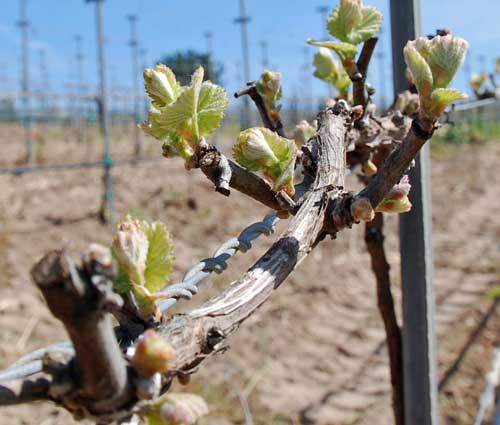
VintageTexas Sunday ‘Cyclopedia of Wine: Bud Break in Texas Wine Country
As of today, it’s now officially Spring 2011. But, in Texas, the grapevines don’t necessarily wait patiently for the official start of spring.
A few weeks back, I was at the Texas Wine and Grape Growers Association (TWGGA) meeting in San Marcos, Texas. Between sessions, I saw Steve Morgan from Saddlehorn Winery (Burton, TX – www.saddlehornwinery.com) with his SmartPhone in hand showing anyone and everyone that would take a gander into his phone’s display, the fuzzy green buds that were emerging from his Blanc Du Bois grapes in his southeast Texas vineyard.
Texas is a large state and just because the buds are inclined to break in the far south east parts, does mean that he vines in other parts of Texas are clamoring to open up, too. However, with the spate of warm weather across the state this year, even up to the areas around Lubbock on the Texas High Plains AVA, it is no surprise that the canes are starting to bleed and the distal buds are starting to push. This signals the time for final pruning that will leave only those buds from which the growth of the new vintage will depend.
The annual growth cycle of the grapevine starts in the spring with bud break. In Texas, this stage begins around March when average daily temperatures begin to surpass 50 F. If the vine had been pruned during the winter, the start of this cycle is signaled by a “bleeding” of the vine. This bleeding occurs when the soil begins to warm and osmotic forces pushes water and its life-giving organic compounds, up from the roots and through the trunk and roughly pruned canes before being expelled from the cuts left over from pruning the vines.
Tiny buds on the vine start to swell and eventually shoots begin to grow from the buds. These buds first appear in the previous summer. During winter the buds scale over and turn brown until the following spring when the vine begins the process of bud break and the first sign of green in the vineyard emerges in the form of tiny shoots.
Eventually the shoots sprout leaves that can begin the process of photosynthesis, producing the energy to accelerate growth. In warm climates, after about 4 weeks, the growth of the shoots starts to rapidly accelerate with the shoots growing in length an average of an inch a day.
In Texas, where temperatures can periodically reach above 50 F in mid-winter or early spring, some early budding varieties (such as Chardonnay and other white grape varieties) can be at risk of premature bud break. This is a potential viticultural hazard, as after bud break, the young shoots are very vulnerable to frost damage if temperatures drop below freezing for an extended period.
One way to delay bud break used by Texas winegrowers is to rough prune during winter, then wait as long as possible to do the final pruning, a process that tends to promote growth of distal buds but delay the opening of the buds close in on the vines that are needed for the upcoming vintage. Other means of fighting early bud break used in Texas vineyards are (1) selection of grape varietals that naturally bud later [examples: white grapes like Roussanne, and red grapes like Mourvedre], and (2) use of evaporative cooling using water emitters that provide a cooling mist to the grapevines during short periods of excessive temperature in late winter or early spring.

From Twitter:
@alamosawineguy: If the wind would ever quit blowing u could prob hear Sang, Viog, Verdelho bud break happening at Tio Pancho Ranch. #txwine